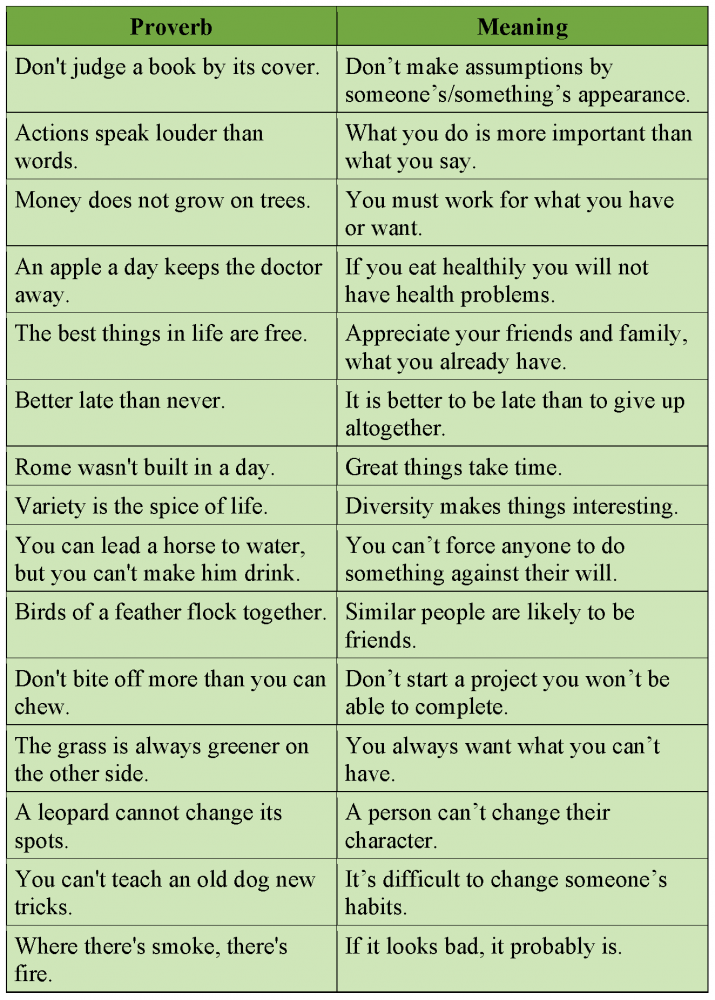
As TESOL professionals, we have the great responsibility to prepare our students for interactions with people unlike themselves. We help students develop the competencies necessary to travel and study internationally, share and access information, and integrate within new communities. Students’ success requires both linguistic and cultural competence, yet in many contexts, the TESOL curriculum prioritizes linguistic objectives over cultural ones (Young & Sachdev, 2011). If teachers focus only on grammar, vocabulary, and structure, we miss a valuable opportunity. By also addressing cultural objectives, we can help our students develop intercultural competence, the ability to understand, respect, and establish relationships with people from different cultures (Byram & Wagner, 2018). Cultural content is not simply an “add-on,” however. It can be integrated within each lesson, even if the curriculum focuses primarily on linguistic features. This article describes how proverbs can help students build language skills while thinking critically about cultural similarities and differences.

Proverbs are popular sayings that hold great communicative power and cultural significance. They can be used with any level, because they often are in the present tense and use basic vocabulary. See Table 1 for a listing of some common English-language proverbs, as well as an explanation of each proverb in plain language.
Table 1. Common English Language Proverbs (click here to enlarge)
Sharing proverbs with students is a great way to help them understand the concept of figurative language, where meaning is alluded to rather than directly stated. Teachers often discuss proverbs with students when relevant vocabulary comes up, or as a motivator at the beginning of class. In the following activity, students work together to unpack the meaning and cultural load of well-known proverbs.
The Activity: Proverb Matching
To prepare, create cards listing either a proverb or its explanation. Think about your students’ prior knowledge and preteach any vocabulary from the proverbs that will be unfamiliar to them. Model the activity by displaying two or three sets of proverbs and explanations on the board and matching them as a class. Then, distribute a card to each student and ask them to find the person whose card matches their own. In other words, they should match the proverb with its meaning. Once each student has found their partner, give them a few minutes to discuss their proverbs together. To support their conversations, you could display one or more discussion questions, such as the following:
-
Are there any similar proverbs in other languages you know?
-
Do you agree with this proverb?
-
In what situations could this proverb be used?
-
Who do you think would say this proverb?
-
What cultural beliefs are hidden in this proverb?
-
Do those cultural beliefs match those of your cultural communities?
After partners have had time to discuss their proverbs, ask each group to share with the class. Lead a class discussion about the meaning and significance of the proverbs.
You can build on or adapt this activity in many ways; see the following section for several suggestions.
Additional Activities
Proverbs Lists and Cards
Ask students to generate a list of proverbs they have heard, or encourage them to keep a list of proverbs they encounter in their readings. Once students are familiar with a number of proverbs, you could use a set of proverb/explanation cards to pair students at random. This activity also offers a great starting point for additional interactive speaking, listening, reading, and writing activities.

Agree or Disagree
After proverbs have been explained to the class, conduct a short listening activity. Designate one side of the room “agree” and the other side “disagree” (for lower levels, it may be helpful to post these words on the wall). Then, read the proverbs again and ask students to move to the side of the room that represents their level of agreement with the proverb. If they are unsure or only slightly agree, they can even stand in the middle of the room. Ask students to discuss why they agree or disagree with a classmate standing near them, then ask them to explain their placement in the room to the class.
Reading and Writing Activities
These common proverbs can also offer a foundation for a variety of reading and writing activities. For example, ask students to create a fictional story explaining how a certain proverb came into being. Or, ask students to write a story that has a certain proverb as its moral.
To encourage critical thinking about a reading, give students texts describing a dilemma, then ask them to supply the proverb that would be appropriate advice in response to that situation. Familiarity with common proverbs can support students’ development of sophisticated reading and writing skills.
Benefits
These activities have a number of beneficial outcomes. Though the language used in proverbs is often quite simple, the correct use of these phrases requires critical thinking and cultural awareness. Focusing on proverbs offers an authentic and engaging context for student discussion. Students will develop the ability to use figurative language communicatively and will also build awareness of the cultural information that is hidden in common sayings. If you have a diverse and multicultural class, students will be exposed to proverbs from other cultures and will have the chance to identify similarities and differences within their communities.
These activities offer an example of how TESOL professionals can integrate cultural content within rich language practice activities. Doing so allows them to diversify the TESOL curriculum and help students develop both the linguistic and cultural competencies necessary for successful communication and connection across lines of difference.
Note: A version of this article first appeared in the April 2020 issue of TESOLers for Social Responsibility.
References
Byram, M., & Wagner, M. (2018). Making a difference: Language teaching for intercultural and international dialogue. Foreign Language Annals, 51, 140–151. http://doi.org/10.1111/flan.12319
Young, T. J., & Sachdev, I. (2011). Intercultural communicative competence: Exploring English language teachers’ beliefs and practices. Language Awareness, 20(2), 81–98. http://doi.org/10.1080/09658416.2010.540328
|
Download this article (PDF) |
Tabitha Kidwell is a language teacher and teacher educator interested in the role of culture in language teaching. She is a faculty member in the TESOL program at American University and has taught languages and trained teachers on five continents.

